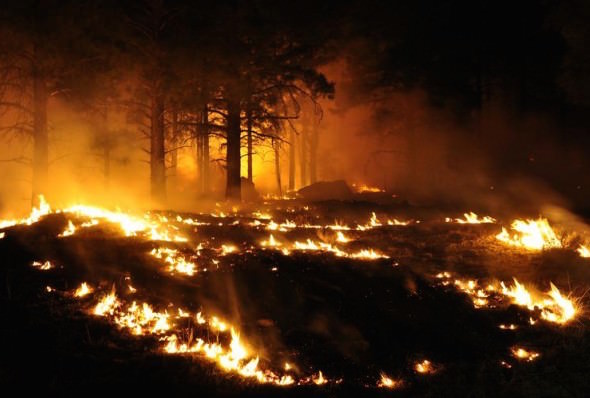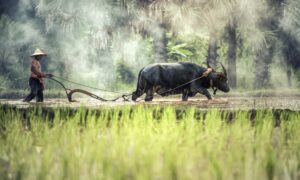A Scorching Earth Threatens U.S. Agriculture
The effects of climate change mean the topsoil that gives the U.S. its agricultural strength is now in jeopardy of being blown away.
By Tim Radford / Climate News Network
/

Wildfires such as this one in Arizona pose a serious risk to topsoil. (Brady Smith / U.S. Forest Service / Coconino via Flickr)
This Creative Commons-licensed piece first appeared at Climate News Network.
LONDON — A deadly mix of prolonged drought and wildfire, driven by climate change, could do more than just lay waste to crops and woodland in the western US. It could scorch the earth and trigger ever greater levels of soil erosion.
Joel Sankey a researcher at the US Geological Survey, told the Geological Society of America’s annual meeting in Baltimore, Maryland, that by 2050 an increase in wildfires may double soil erosion in some western states. As a consequence, soil would blow or be washed into water courses.
He and his colleagues used computer models to see what projected increases in wildfire could do throughout the West in the first half of this century.
Researchers have already warned that California’s present sustained drought is an indicator of things to come, and that rising average temperatures and more frequent heat waves must mean greater wildfire hazards.
Rich mix
But the scientists looked beyond the drought and fire to see the consequences for soil erosion.
Topsoil is a rich mix of weathered rock, minerals, trace elements and decaying vegetation that supports a huge community of tiny living things that recycle nutrients. It is the natural substrate that absorbs and holds water and nourishes all green growth. Topsoil also underwrites the wealth of the US, a great agricultural power.
But fire can change the nature of the soil, turning it into hot, charred dust that can blow away in the wind, or — equally dangerously — baking its surface so that falling rain or melting snow runs off directly, rather than percolating into the sediment. Either way, the topsoil can end up in the nearest creek, to choke rivers or muddy the reservoirs.
“We can identify municipalities that are
future hotspots, and figure out how fire and erosion
impact that community.”
“The sediment can have a wide range of effects on a lot of watersheds, many of which are headwater streams and important for water supply in the West,” Dr Sankey says.
The models predicted that erosion would at least double in a quarter of western US watersheds. Two-thirds of the watersheds are projected to experience at least 10% more erosion by mid-century.
Sediment loss
Some of the largest projected increases could happen in northern California and the high hills of southern California, both regions expected to see even more fires, followed by greater sediment loss from the steep mountainsides.
Research of this kind is designed not just to alert citizens and state authorities to the direct costs of climate change driven by man-made warming of the planet as a consequence of the combustion of fossil fuels. It is also designed to help county and state planners prepare for the future.
“We can identify municipalities that are future hotspots and figure out how fire and erosion impact that individual community,” Dr Sankey said. “The next team can work with more detailed, finer-scale models and estimate what conditions will look like in these watersheds.”
Tim Radford, a founding editor of Climate News Network, worked for The Guardian for 32 years, for most of that time as science editor. He has been covering climate change since 1988.
Your support matters…Independent journalism is under threat and overshadowed by heavily funded mainstream media.
You can help level the playing field. Become a member.
Your tax-deductible contribution keeps us digging beneath the headlines to give you thought-provoking, investigative reporting and analysis that unearths what's really happening- without compromise.
Give today to support our courageous, independent journalists.






You need to be a supporter to comment.
There are currently no responses to this article.
Be the first to respond.